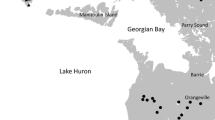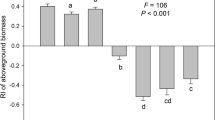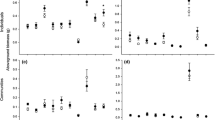Abstract
Invasions at high latitudes are recognized as an emerging threat to native biodiversity, but non-native plants still are scarce in northern Canada. One factor potentially inhibiting further invasions may be below-ground interactions; in particular, it is unclear whether interactions with soil biota are likely to help or hinder the spread of new species into often challenging northern soils. In the Canadian subarctic, the non-native plant Linaria vulgaris has invaded human-disturbed soils in the town of Churchill, Manitoba (58.8°N) but for decades has failed to spread into natural communities. One explanation for this stasis might be greater resistance by soil communities in uninvaded areas relative to areas where this plant is established; however, no local evidence for plant-soil feedbacks exists. In one of the first papers to test the potential role of plant-soil feedbacks in an invasion at high latitudes, we planted L. vulgaris in soil serially inoculated with live and sterilized field-collected soil sampled from invaded or uninvaded sites, and measured plant performance (biomass) over three iterations. We also conducted soil chemical analyses to determine whether pH, and carbon, nitrogen, and phosphorous contents differ between invaded and uninvaded areas. There was no initial difference in biomass between inoculation treatments in the first two iterations. However, by iteration 3, we found that sterilization significantly increased L. vulgaris biomass in invaded soils, indicating feedback becomes negative in invaded soils compared to uninvaded soils. Soil chemistry did not differ significantly between invaded and uninvaded soils, though there was a tendency for invaded soils to contain more carbon and nitrogen. These results do not support the hypothesis that L. vulgaris is absent from uncolonized sites because soil communities resist invasion. Instead, they provide evidence that L. vulgaris is inhibited by plant-soil feedbacks in invaded soils, while feedbacks in native-dominated soils are not a barrier to further local spread. Thus, explanations for the restriction of this species must lie elsewhere.




Similar content being viewed by others
Data availability
The datasets and code generated during the current study will be made publicly available on Dryad after the manuscript is accepted. The datasets and code are currently available from the corresponding author upon reasonable request.
References
Alsos IG, Ware C, Elven R (2015) Past Arctic aliens have passed away, current ones may stay. Biol Invasions 17:3113–3123
Beckett E (1959) Adventive plants at Churchill, Manitoba. Can Field Nat 73:169–173
Beckstead J, Parker IM (2003) Invasiveness of Ammophila arenaria: release from soil-borne pathogens? Ecology 84:2824–2831
Bever JD, Westover KM, Antonovics J (1997) Incorporating the soil community into plant population dynamics: the utility of the feedback approach. J Ecol 85:561–573
Brinkman EP, der Putten WHV, Bakker E-J, Verhoeven KJF (2010) Plant–soil feedback: experimental approaches, statistical analyses and ecological interpretations. J Ecol 98:1063–1073
Callaway RM, Thelen GC, Barth S, Ramsey PW, Gannon JE (2004a) Soil fungi alter interactions between the invader Centaurea maculosa and North American natives. Ecology 85:1062–1071
Callaway RM, Thelen GC, Rodriguez A, Holben WE (2004b) Soil biota and exotic plant invasion. Nature 427:731–733
Charlton WA (1966) The root system of Linaria vulgaris Mill.: I—Morphology and Anatomy. Can J Bot 44:1111–1116
Chen I (2012) Rapid range shifts of species. Science 1024:17–20
Chung YA (2023) The temporal and spatial dimensions of plant–soil feedbacks. New Phytol 237:2012–2019
Colautti RI, Bailey SA, Van Overdijk CDA, Amundsen K, MacIsaac HJ (2006) Characterised and projected costs of nonindigenous species in Canada. Biol Invasions 8:45–59
Conservation of Arctic Flora and Fauna & Protection of the Arctic Marine Environment (2017) Arctic Invasive Alien Species Plan.
Dawson W, Schrama M (2016) Identifying the role of soil microbes in plant invasions. J Ecol 104:1211–1218
Dietrich P, Cesarz S, Eisenhauer N, Roscher C (2020) Effects of steam sterilization on soil abiotic and biotic properties. SOIL Org 92:99–108
Diez JM, Dickie I, Edwards G, Hulme PE, Sullivan JJ, Duncan RP (2010) Negative soil feedbacks accumulate over time for non-native plant species: plant-soil feedbacks change over time. Ecol Lett 13:803–809
Dudenhöffer J-H, Ebeling A, Klein A-M, Wagg C (2018) Beyond biomass: soil feedbacks are transient over plant life stages and alter fitness. J Ecol 106:230–241
Ehrenfeld JG (2010) Ecosystem consequences of biological invasions. Annu Rev Ecol Evol Syst 41:59–80
Elton CS (1958) The ecology of invasions by animals and plants. Springer International Publishing, Cham
Endlweber K, Scheu S (2006) Establishing arbuscular mycorrhiza-free soil: a comparison of six methods and their effects on nutrient mobilization. Appl Soil Ecol 34:276–279
Engelkes T, Morriën E, Verhoeven KJF, Bezemer TM, Biere A, Harvey JA et al (2008) Successful range-expanding plants experience less above-ground and below-ground enemy impact. Nature 456:946–948
Flory SL, Alba C, Clay K, Holt RD, Goss EM (2018) Emerging pathogens can suppress invaders and promote native species recovery. Biol Invasions 20:5–8
Gardes M, Dahlberg A (1996) Mycorrhizal diversity in arctic and alpine tundra: an open question. New Phytol 133:147–157
Gibbons SM, Lekberg Y, Mummey DL, Sangwan N, Ramsey PW, Gilbert JA (2017) Invasive plants rapidly reshape soil properties in a grassland ecosystem. mSystems 2:e00178-16
Gundale MJ, Kardol P, Nilsson M-C, Nilsson U, Lucas RW, Wardle DA (2014) Interactions with soil biota shift from negative to positive when a tree species is moved outside its native range. New Phytol 202:415–421
Gundale MJ, Wardle DA, Kardol P, Nilsson M-C (2019) Comparison of plant-soil feedback experimental approaches for testing soil biotic interactions among ecosystems. New Phytol 221:577–587
Guo Q, Cade BS, Dawson W, Essl F, Kreft H, Pergl J et al (2021) Latitudinal patterns of alien plant invasions. J Biogeogr 48:253–262
Hargreaves SK, Horrigan EJ, Jefferies RL (2009) Seasonal partitioning of resource use and constraints on the growth of soil microbes and a forage grass in a grazed Arctic salt-marsh. Plant Soil 322:279–291
Henry GHR, Freedman B, Svoboda J (1986) Effects of fertilization on three tundra plant communities of a polar desert oasis. Can J Bot 64:2502–2507
Hobbie JE, Hobbie EA (2006) 15n in symbiotic fungi and plants estimates nitrogen and carbon flux rates in Arctic Tundra. Ecology 87:816–822
Inderjit, van der Putten WH (2010) Impacts of soil microbial communities on exotic plant invasions. Trends Ecol Evol 25:512–519
Iversen CM, Sloan VL, Sullivan PF, Euskirchen ES, McGuire AD, Norby RJ et al (2015) The unseen iceberg: plant roots in arctic tundra. New Phytol 205:34–58
Kardol P, Bezemer TM, van der Putten WH (2006) Temporal variation in plant–soil feedback controls succession. Ecol Lett 9:1080–1088
Keane RM, Crawley MJ (2002) Exotic plant invasions and the enemy release hypothesis. Trends Ecol Evol 17:164–170
Kent A, Drezner TD, Bello R (2018) Climate warming and the arrival of potentially invasive species into boreal forest and tundra in the Hudson Bay Lowlands. Canada Polar Biol 41:2007–2022
Klironomos JN (2002) Feedback with soil biota contributes to plant rarity and invasiveness in communities. Nature 417:67–70
Klironomos JN (2003) Variation in plant response to native and exotic arbuscular mycorrhizal fungi. Ecology 84:2292–2301
Knevel IC, Lans T, Menting FBJ, Hertling UM, van der Putten WH (2004) Release from native root herbivores and biotic resistance by soil pathogens in a new habitat both affect the alien Ammophila arenaria in South Africa. Oecologia 141:502–510
Kulmatiski A, Beard KH, Stevens JR, Cobbold SM (2008) Plant–soil feedbacks: a meta-analytical review. Ecol Lett 11:980–992
Lang JA, Roth JD, Markham JH (2021) Foxes fertilize the subarctic forest and modify vegetation through denning. Sci Rep 11:3031
Liao C, Peng R, Luo Y, Zhou X, Wu X, Fang C et al (2008) Altered ecosystem carbon and nitrogen cycles by plant invasion: a meta-analysis. New Phytol 177:706–714
MacKay J, Kotanen PM (2008) Local escape of an invasive plant, common ragweed (Ambrosia artemisiifolia L.), from above-ground and below-ground enemies in its native area. J Ecol 96:1152–1161
Maron JL, Waller L, Callaway RM (2014) Invasive plants escape from suppressive soil biota at regional scales. J Ecol 102:19–27
Moyano J, Rodriguez-Cabal MA, Nuñez MA (2021) Invasive trees rely more on mycorrhizas, countering the ideal-weed hypothesis. Ecology 102:e03330
Mulder CPH, Iles DT, Rockwell RF (2017) Increased variance in temperature and lag effects alter phenological responses to rapid warming in a subarctic plant community. Glob Change Biol 23:801–814
Myers-Smith IH, Grabowski MM, Thomas HJD, Angers-Blondin S, Daskalova GN, Bjorkman AD et al. (2019) Eighteen years of ecological monitoring reveals multiple lines of evidence for tundra vegetation change. Ecol. Monogr. 89.
Nadeau LB, King JR, Harker KN (1992) Comparison of growth of seedlings and plants grown from root pieces of yellow toadflax (Linaria vulgaris). Weed Sci 40:43–47
Nijjer S, Rogers WE, Siemann E (2007) Negative plant–soil feedbacks may limit persistence of an invasive tree due to rapid accumulation of soil pathogens. Proc r Soc B Biol Sci 274:2621–2627
Nuske SJ, Fajardo A, Nuñez MA, Pauchard A, Wardle DA, Nilsson M-C et al (2021) Soil biotic and abiotic effects on seedling growth exhibit context-dependent interactions: evidence from a multi-country experiment on Pinus contorta invasion. New Phytol 232:303–317
Pendleton RL, Smith BN (1983) Vesicular-arbuscular mycorrhizae of weedy and colonizer plant species at disturbed sites in Utah. Oecologia 59:296–301
Read DJ, Leake JR, Perez-Moreno J (2004) Mycorrhizal fungi as drivers of ecosystem processes in heathland and boreal forest biomes. Can J Bot 82:1243–1263
Reinhart KO, Callaway RM (2004) Soil biota facilitate exotic acer invasions in Europe and north AMERICA. Ecol Appl 14:1737–1745
Reinhart KO, Callaway RM (2006) Soil biota and invasive plants. New Phytol 170:445–457
Reinhart KO, Rinella MJ (2016) A common soil handling technique can generate incorrect estimates of soil biota effects on plants. New Phytol 210:786–789
Reinhart KO, Packer A, der Putten WHV, Clay K (2003) Plant–soil biota interactions and spatial distribution of black cherry in its native and invasive ranges. Ecol Lett 6:1046–1050
Ricciardi A, Hoopes MF, Marchetti MP, Lockwood JL (2013) Progress toward understanding the ecological impacts of nonnative species. Ecol Monogr 83:263–282
Saner MA, Clements DR, Hall MR, Doohan DJ, Crompton CW (1995) The biology of Canadian weeds: 105—Linaria vulgaris mill. Can J Plant Sci 75:525–537
Schittko C, Wurst S (2014) Above- and belowground effects of plant-soil feedback from exotic Solidago canadensis on native Tanacetum vulgare. Biol Invasions 16:1465–1479
Staniforth RJ, Scott PA (1991) Dynamics of weed populations in a northern subarctic community. Can J Bot 69:814–821
Suding KN, Harpole WS, Fukami T, Kulmatiski A, MacDougall AS, Stein C et al (2013) Consequences of plant–soil feedbacks in invasion. J Ecol 101:298–308
Van Grunsven RHA, Van Der Putten WH, Bezemer TM, Tamis WLM, Berendse F, Veenendaal EM (2007) Reduced plant–soil feedback of plant species expanding their range as compared to natives. J Ecol 95:1050–1057
Vandegehuchte ML, de la Peña E, Bonte D (2010) Relative importance of biotic and abiotic soil components to plant growth and insect herbivore population dynamics. PLoS ONE 5:e12937
Vitousek PM, Walker LR, Whiteaker LD, Mueller-Dombois D, Matson PA (1987) Biological invasion by Myrica faya alters ecosystem development in Hawaii. Science
Vitousek PM, D’Antonio CM, Loope LL, Rejmánek M, Westbrooks R (1997) Introduced species: a significant component of human-caused global change. NZ J Ecol 21:1–16
Wasowicz P, Sennikov AN, Westergaard KB, Spellman K, Carlson M, Gillespie LJ et al (2020) Non-native vascular flora of the Arctic: taxonomic richness, distribution and pathways. Ambio 49:693–703
Wolfe BE, Klironomos JN (2005) Breaking new ground: soil communities and exotic plant invasion. Bioscience 55:477–487
Zhang P, Li B, Wu J, Hu S (2019) Invasive plants differentially affect soil biota through litter and rhizosphere pathways: a meta-analysis. Ecol Lett 22:200–210
Acknowledgements
We would like to thank LeeAnn Fishback and the science technicians at the Churchill Northern Studies Centre (CNSC) for collecting soil samples and shipping them to the University of Toronto Mississauga for our experiment, and the Koffler Scientific Reserve (KSR) for allowing seed collection. We would also like to thank Tim Duval and the Department of Geography, Geomatics and Environment (GGE) at UTM for letting us borrow their equipment for pH measurements, and Soham Raikar for assisting with lab work, especially biomass measurements.
Funding
This work was supported by an NSERC Discovery Grant to PMK (Grant number: RGPIN-2016–06095), and funding from the Northern Scientific Training Program, a Sigma Xi Grant-in-aid of Research, and an Ontario Graduate Scholarship to VMZ.
Author information
Authors and Affiliations
Contributions
All authors contributed to the study conception and design. Material preparation, data collection, and analyses were performed by V.M. Zhang. The first draft of the manuscript was written by V.M. Zhang, and all authors commented on previous versions of the manuscript. All authors read and approved the final manuscript.
Corresponding author
Ethics declarations
Competing interest
The authors have no competing financial or non-financial interests to declare.
Additional information
Communicated by Jaime Moyano.
Publisher's Note
Springer Nature remains neutral with regard to jurisdictional claims in published maps and institutional affiliations.
Supplementary Information
Below is the link to the electronic supplementary material.
Rights and permissions
Springer Nature or its licensor (e.g. a society or other partner) holds exclusive rights to this article under a publishing agreement with the author(s) or other rightsholder(s); author self-archiving of the accepted manuscript version of this article is solely governed by the terms of such publishing agreement and applicable law.
About this article
Cite this article
Zhang, V.M., Kotanen, P.M. Development of negative soil feedback by an invasive plant near the northern limit of its invaded range. Plant Ecol 224, 635–645 (2023). https://doi.org/10.1007/s11258-023-01330-4
Received:
Accepted:
Published:
Issue Date:
DOI: https://doi.org/10.1007/s11258-023-01330-4




